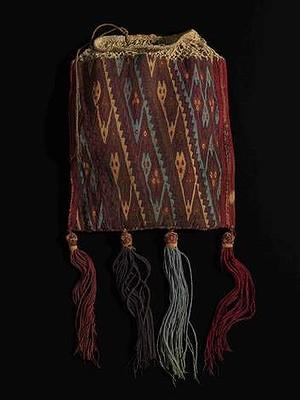Despite its age, a Nazca woven pouch is in remarkable condition

Pouch with tassels, circa AD400, wool and cotton, woven. Photo: National Gallery of Australia
While the western world witnessed the end of the Roman Empire, the birth of the Byzantine Empire and the establishment of Catholicism as the primary European religion, an extremely skilled Nazca artist was spinning, dyeing and weaving an exquisite textile on the south coast of Peru. The Nazca pouch on display in Gold and the Incas: Lost worlds of Peru is the oldest textile in the National Gallery of Australia's collection at 1600 years. As a textile conservator, to touch and handle a piece like this is an exceptional and honoured privilege.
One of the many astonishing things about this textile is the remarkable condition it is in for its age. As with many Pre-Columbian works of art, exactly where it has come from is often hard to determine. Many Peruvian archaeological sites were not recorded as meticulously as they are at modern excavations. Why and how this piece survived in particularly excellent condition is a mystery. It remains very tactile and soft to the touch, with none of the brittleness typically suffered by textiles of a similar age, and even younger ones. As you hold it in your hands you feel a great connection with its original owner and you imagine who they were and what they used the pouch for.
The fineness of the spun yarn used to construct the pouch is mind-blowing. An indication of this can be seen in the four tassels on the lower edge. Each of these has on average 21 strands composed of roughly 21 yarns - each is two ply. This equals 882 single spun yarns in each of the four tassels. These have been spun by hand, not on a wheel, using a drop spindle producing a yarn that is, in many cases, finer than a human hair.
To me, the most intriguing aspect is the anomalies found in the weave pattern on the front and back. To think that this culture was so clever that its people created enormous zoomorphic, human and geometric geoglyphs on the desert plains, but made several errors in the pattern on a 30-centimetre-square piece of weaving is inconceivable. Looking closely at the pouch, you can see at the edges the pattern of the tessellating cats is out of sync in both colour and pattern. This would have been apparent to the weaver; who could, had they wanted to, have undone the previous weaving and corrected the mistake. Whether the mistakes were deliberate and had meaning or were the rudimentary errors of a novice or a rushed job under constraints of a hurried burial item we will never know. The mysterious weave-pattern irregularities on this pouch are one of its most endearing qualities, making it a unique, treasured and fascinating textile, and a thing of great beauty.
Hannah Barrett is the textile conservator at the National Gallery of Australia.